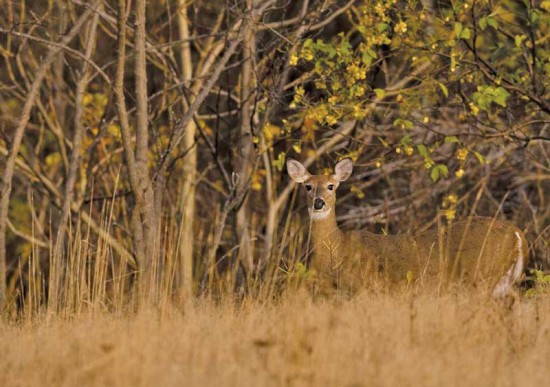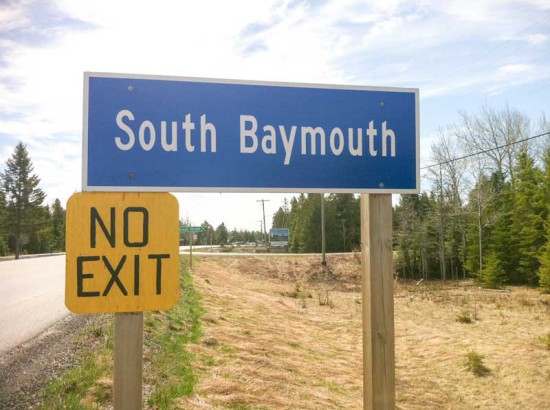KAGAWONG—At the recommendation of the Manitoulin Deer Management Committee and local fish and game clubs, the number of antlerless deer tags provided by the Ministry of Natural Resources (MNR) for the annual Manitoulin deer gun hunt will remain the same for both wildlife management units (WMU) 43A and 43B.
“I think I can sell that this year, but if the harvest numbers show there is an increase in the number of deer next year, we will have to look at raising the number of permits,” stated Wayne Selinger, area biologist with the MNR Espanola office, at a meeting of the committee last week.
Mr. Selinger provided a series of statistics for 2012 and previous years on indicators of where the deer herd is on the Island in terms of numbers, and the health of the herd. For example, “the number of deer-motor vehicle accidents are up again, which is a good indicator of the herd numbers. He noted, “we saw our peak number on deer levels in 2003, and the deer numbers declined in 2008-2009. They appear to be high in 2012 with an increasing herd trend since 2009. There was a total of 200 (MVA) accidents this year.”
The deer seen per hunter per day peaked in 2003 on Manitoulin and has been increasing since 2010-2012, the meeting was told. “There has been a stable to slight increase in 43A. As for hunter success in 43A while there was a long-term decline there was a slight increase in 2012. The numbers were stable on the West End,” said Mr. Selinger.
For 43A the hunter success “was the same as the MVAs, so it appears we have turned the corner,” said Mr. Selinger. “There has been an increasing trend in deer numbers since 2010.”
The estimated harvest trend for 2012 was 350 animals in 43A and 2,872 in 43B, the meeting was told. Mr. Selinger said that based on harvest data, the 3,222 harvested in 2012 is up a little from the previous year of 2,989.
In 43A, in looking at the harvest breakdown from the years 2008-2011, there has been a big reduction seen in the number of bucks, said Mr. Selinger. He explained in comparison to other WMUs in the province, and taking everything into account such as hunting pressure and the harvest, for 43A “it is the middle of the road provincially.” For 43B, “we are extremely high compared to the rest of the province, in terms of hunting effort and harvest intensity, we are right at the top 10 percent for kill compared to other WMUs.”
“From the check station held in 2012, the number of deer seen was down again with just over 600 animals coming through,” Mr. Selinger said. This included 35 percent does and 65 percent bucks.
Mr. Selinger provided other statistics that point to the deer population possibly going through an upward swing.
“We had the coldest winter on record in lot of parts of the country, and deer are stressed,” said Ian Anderson. On the Island, “this is the coldest winter we had in at least four-five years and there was a crust on the school the last three weeks of the winter, at the time deer are stressed the most; and they were going through the crust when nothing else did.”
Mr. Selinger said the Island should have a decent fawn crop this year, noting the number of wolves seen per hunter, which had peaked in 43B in 2009, came down substantially, about half the population there used to be.
“I target predators, and my peak year was a kill of 47 wolves in 2010,” said Mr. Anderson. “What I’ve noticed especially this year is we are not seeing any large family units. The rabbit population crashed, and deer numbers went down, so the wolves-coyotes six-seven family unit went to two or three. I support the point that the predator population is somewhat down, but I’ve seen an increase in the number of timber wolves.”
For 43A, with the deer population having declined but now appearing to be stable, and with the mild winter, there should be an excellent fawn crop, said Mr. Selinger. He recommended that the deer tags issued should remain at 400.
Mr. Anderson noted the recommendation from the Gore Bay Fish and Game Club was the same, for the deer tag numbers to remain the same for 43A.
For WMU 43B, “the population is going through an upward cycle,” said Mr. Selinger. “In summary, the hunter pressure is very high, and I would suggest the density is increasing and is on the high scale compared to provincial averages. The deer conditions have improved, and the past three winters have been mild. The goal is to maintain the deer populations, and my recommendation is a proposed quota of 4,000 (500 more than in 2012). The bottom line is increasing the tags. That would be a recognition we are turning the corner and the population is increasing.”
However, Mr. Anderson said, “one thing I pay close attention to is small fawns. When we lose deer after a hard winter we see most of the loss in April. On April 15 I saw really small fawns, physically they look as if they have the mumps. That day I saw five, and three days later a buck fawn had been hit on the road in front of me. It looked healthy until I picked it up. For almost one-year-old, it weighed 43 pounds, which says to me it is a damaged deer.”
“I took it home, I skinned the animal and the back rib cage was standing out about an inch,” Mr. Anderson said, noting when he cut the back bone on the deer, “what flowed out had the acidity of Campbell’s soup. And this was a fawn that looked good. We will be losing some fawns from this winter, no doubt.”
Mr. Anderson pointed out that both the Gore Bay and United Fish and Game Clubs of Manitoulin have recommended the deer tag numbers remain at 3,500 for 43B.
“I was prepared to vote for higher numbers but after hearing Ian’s points and others here tonight I agree the numbers should remain the same,” said Lee Hayden.
“I’ll go with what the group feels this year (for status in 43B),” said Mr. Selinger, although he said this will be revisited again next year.





